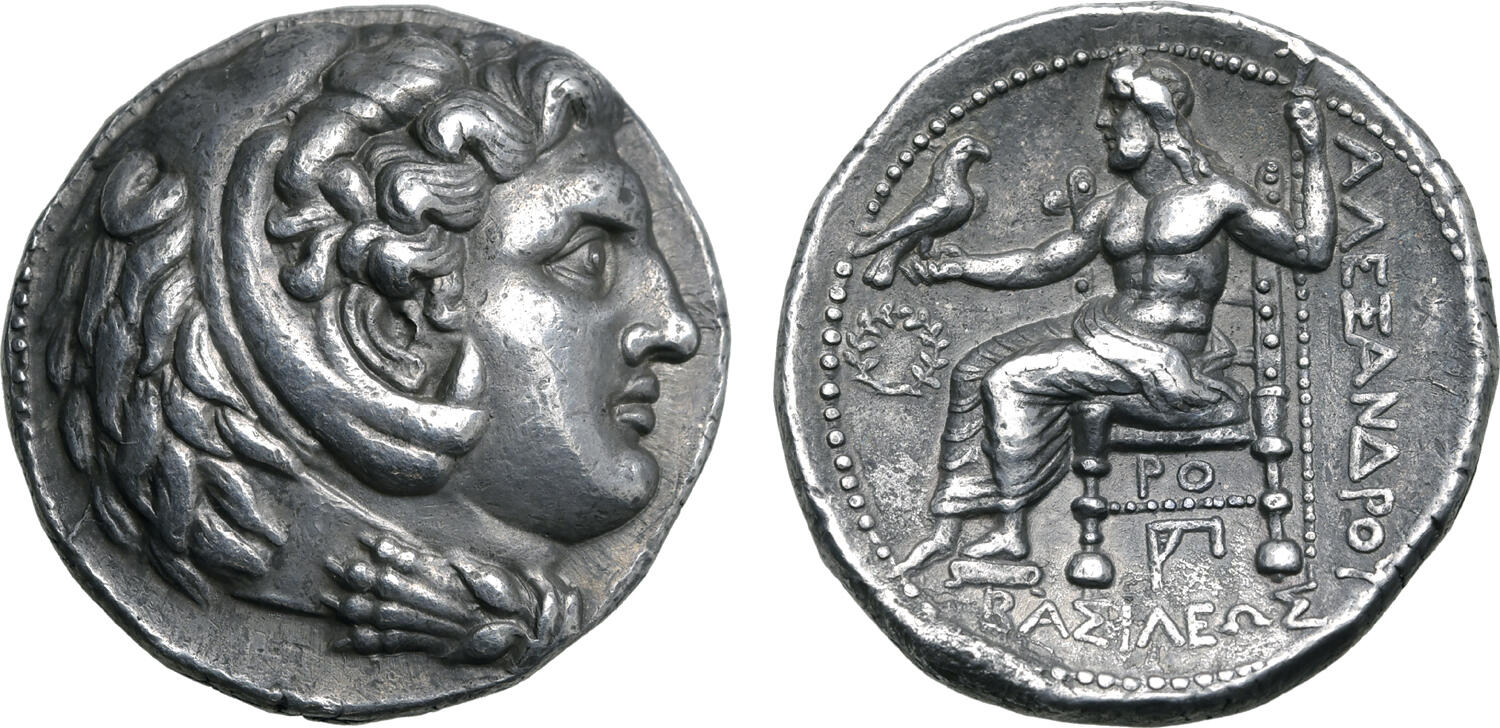Susa (Seleucus I), silver, tetradrachms (wreath group) (Heracles/seated Zeus) (311-308 BCE)
From SILVER
311 BCE - 308 BCE Silver 2,726 kg
Description
| ObverseInscription or printing placed on the obverse.: | Head of Herakles to right, wearing lion skin headdress |
| ReverseInscription or printing placed on the reverse.: | ΒΑΣΙΛΕΩΣ below, ΑΛΕΞΑΝΔΡΟΥ to right (Greek).Zeus Aëtophoros seated to left, holding sceptre, wreath in left field, PO above strut, monogram below throne |
Mint and issuing power
| MintIdentifies the place of manufacture or issue of a numismatic object.: | Susa | Ancient regionAncient region.: | Mesopotamia | Modern countryModern country: Iran | AuthorityIdentifies the issuing power. The authority can be "pretended" when the name or the portrait of X is on the coin but he/she was not the issuing power. It can also be "uncertain" when there is no mention of X on the coin but he/she was the issuing power according to the historical sources: | Alexander III the Great (Argead king, 336-323 BC), Seleucid Dynasty (312-63 BC), Seleucus I Nicator (satrap in 321-305 BC and Seleucid king in 305-281 BC) |
Chronology
| FromIdentifies the initial date in a range assigned in a numismatic context. | 311 BCE | toIdentifies the final date in a range assigned in a numismatic context.. | 308 BCE | PeriodTime period of the numismatic object.: Hellenistic 323-30 BC |
Physical description
| MetalThe physical material (usually metal) from which an object is made.: | Silver |
Median weightMedian of the weights of numismatic objects (in grams). in grams | 17.10 | DenominationTerm indicating the value of a numismatic object. Examples: tetradrachm, chalkous, denarius.: | tetradrachm |
StandardStandard.: | Attic |
Image

S1912 Susa Seleucus wreath.jpg [1]
References
| Die study referencePublication of the study: | Taylor 20191Taylor 2019 | ||
| Coin series referenceReference to coin series study: | Price 19912Price 1991, n° 3853-3860 | ||
| Coin series web referenceCoin series web references: | |||
Obverse dies distribution
| FrequencyFrequency of specimen in distribution. ᵖ | Number of obversesNumber of obverse dies. ᵖ (o) | % (o) | Number of coinsNumber of coins. (n) | % (n) | Die nameName(s) of the die(s). |
| 1 | 1 | 12.5 | 1 | 0.97 | 1 |
| 2 | 1 | 12.5 | 2 | 1.94 | 2 |
| 5 | 1 | 12.5 | 5 | 4.85 | 3 |
| 6 | 1 | 12.5 | 6 | 5.83 | 5 |
| 9 | 1 | 12.5 | 9 | 8.74 | 7 |
| 10 | 1 | 12.5 | 10 | 9.71 | 6 |
| 29 | 1 | 12.5 | 29 | 28.16 | 4 |
| 41 | 1 | 12.5 | 41 | 39.81 | 8 |
| Total | 8 of 8 | 100 | 103 of 103 | 100.01 |
Reverse dies distribution
no distribution is available
Quantification
| Number of obversesNumber of obverse dies. ᵖ (o) | 8 | Number of singletons (o1)The number of singleton coins. ᵖ | 1 |
| Number of reverse diesNumber of reverse dies. (r) | 45 | Number of coinsNumber of coins. (n) | 103 |
| Coins per obverse dieNumber of coins per obverse die. (n/o) | 12.88 | Coins per reverse dieNumber of coins per reverse die. (n/r) | 2.29 |
| Reverse per obverse ratioRatio of obverse dies divided by reverse dies. (r/o) | 5.63 | Percentage of singletons (o1)number of coins (n) divided by the number of singletons (o1) ᵖ | 12.5 % |
| Original number of dies (O) (Carter 1983 formula)The estimation of the number of coins according to Carter 1983 ᵖ | 7.97 | Coins struck if 20,000 as average productivity per dieCoins made if the average productivity for obverses (according to Carter) is 20,000. ᵖ | 159,400 |
| Original number of dies (O) (Esty 2011 formula)The estimation of the number of coins according to the singleton formula in Esty 2011 ᵖ (O) | 8.67 | Survival rate if 20,000 as average productivity per dieSurvival rate if average productivity is 20,000. ᵖ | 0.00065 |
| Coverage (o = % of O) (Esty 1984 formula)Esty 1984 - coverage (% of O) ᵖ (o = % of O) | 99.03% | Die productivity if survival rate 1/2,000Average productivity if survival rate is 1/2,000. ᵖ | 25,846.93 |
| Weight of silver (in kg) if 20,000 coins per die (O = Carter formula)Carter 1983 * Median weight * 20000 (*10 if gold or electrum) ᵖ | 2,726 kg <br /> 2,726 kg | Die productivity if survival rate 1/5,000Average productivity if survival rate is 1/5,000. ᵖ | 64,617.31 |
Remarks
Most likely one single workstation Likely military
References
- ^ Taylor, Lloyd W. H. (2019), "The Susa Wreath Group Alexanders: The First Step in the Transformation of an Anchor Seal to a Dynastic Emblem," Koinon. The International Journal of Classical Numismatic Studies, 2, p. 63-83.
- ^ Price, Martin Jessop (1991), The Coinage in the Name of Alexander the Great and Philip Arrhidaeus: a British Museum Catalogue, 2 vol., Zürich-London, 637 p., 637 p., clix pl.